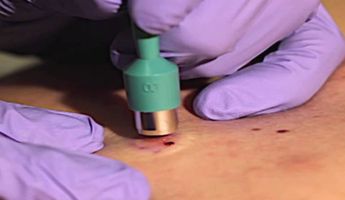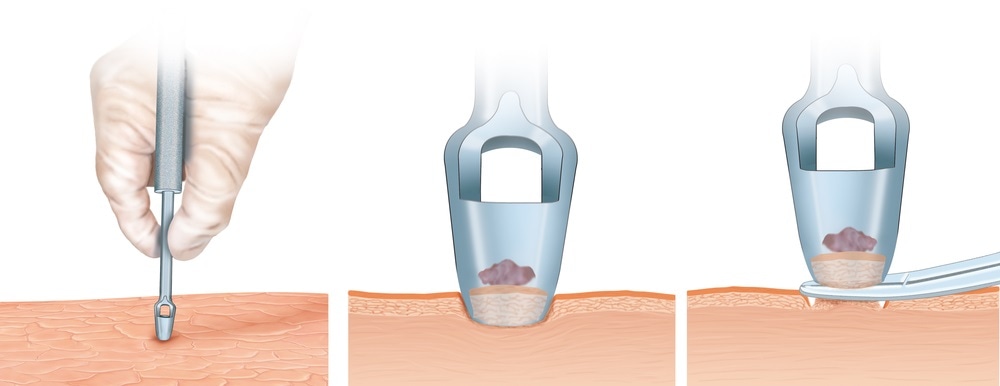Skin Biopsy in Paris
Search and Compare the Best Clinics and Doctors at the Lowest Prices for Skin Biopsy in Paris

Find the best clinics for Skin Biopsy in Paris
No pricing info available
Ukraine offers the best prices Worldwide
Price: $ 106
From 161 verified reviews
latifa Rabhi, 06 September 2020
Very fast support, with highly qualified and human staff.The rooms are beautiful and very quiet.Calm and gentleness in this hospital, I highly recommend.
WHY US?
At Medijump, we're making medical easy. You can search, compare, discuss, and book your medical all in one place. We open the door to the best medical providers worldwide, saving you time and energy along the way, and it's all for FREE, no hidden fees, and no price markups guaranteed. So what are you waiting for?

Free

Best Price

Widest Selection

Risk-Free
What you need to know about Skin Biopsy in Paris

A skin biopsy is a procedure in which cells or skin samples are removed from the surface of the body to be tested. The sample taken from a skin biopsy is sent to a laboratory and examined by a pathologist under a microscope. By looking at the sample, the pathologist can diagnose or rule out skin cancer. In some cases, it can also be used to remove skin lesions.
A skin biopsy is needed to diagnose or to help treat skin conditions and diseases, including skin infection, warts, actinic keratosis, skin tags, suspicious moles or other growths, blistering skin disorders (such as bullous pemphigoid), inflammatory skin conditions (such dermatitis and psoriasis), and skin cancers (including melanoma, squamous cell carcinoma, and basal cell carcinoma).
What does the Procedure Involve?
Before the procedure, your doctor cleans the area of the skin to be biopsied. Your skin may be marked to outline the biopsy area. You will then be given a local anaesthetic to numb the biopsy site.
How your doctor performs the procedure depends on the type of biopsy.
-
Shave biopsy – during this type of biopsy, your doctor uses a sharp tool, scalpel or double-edged razor to remove a small section of the top layers of your skin (epidermis and a portion of the dermis).
-
Punch biopsy – your doctor uses a circular instrument called a punch in order to remove a small section of your skin, including the deeper layers (epidermis, dermis, as well as superficial fat).
-
Excisional biopsy – your doctor uses a small scalpel in order to remove an area of abnormal skin, which includes a portion of normal skin down to the fatty layer of skin. This type of biopsy can also be done to remove an entire lump, usually smaller lesions.
-
Incisional biopsy – a scalpel is used to remove a small sample of large lesions.
While a shave biopsy usually does not need stitches, punch biopsy, excisional biopsy, and incisional biopsy usually require stitches to close the wound as they involve cutting into the uppermost layer of fat underneath the skin.
How Long Should I Stay in Paris?
A skin biopsy usually takes around 15 minutes to complete. It is an outpatient procedure, so you can leave the hospital on the same day as your skin biopsy. However, since the results are available within several days or weeks, you need to stay in Paris for at least 7 days following your biopsy. Once the result is available, you will need to attend a follow-up visit to discuss the results of the test with your doctor.
What's the Recovery Time?
In general, you should rest as much as possible for the remainder of the day and go back to your normal activities the day after. However, you need to take it easy and avoid vigorous activities for a few days to avoid complications. How long it takes your biopsy site to heal depends upon the depth and size of the biopsy, which may take about 2 to 3 weeks.
What About Aftercare?
Following the biopsy, your doctor will give you aftercare instructions. Follow the instructions carefully for a quick and smooth recovery. You may experience some soreness on or around the biopsy site for a few days, but you can take Tylenol to relieve any discomfort. If you have stitches, make sure to keep the area clean. Try not to do any activities that might stretch the skin as it could enlarge the scar and cause the wound to bleed.
What's the Success Rate?
A skin biopsy is a safe and accurate method to diagnose skin conditions and diseases. The accuracy of a shave biopsy is 97%, while a punch biopsy is shown to be 85% accurate. The result of a skin biopsy is highly dependent on the quality of the biopsy submitted. It is possible to miss the diagnosis of a skin tumour.
The result of your skin biopsy will include a diagnosis and a description of the skin condition. If the sample is found to be cancerous, the description will include information about how quickly the cancer cells are dividing, the thickness and margins of the tumour, the presence of tiny tumours near the main tumour, as well as invasion of the tumour into a nerve, blood vessel, or lymph vessel.
While a skin biopsy is a generally safe procedure, complications can still occur. These include bleeding, bruising, infection, scarring, and allergic reaction to the anaesthesia.
Are there Alternatives to Skin Biopsy?
A skin biopsy is needed to diagnose and treat skin conditions and diseases. There are currently no other alternatives to diagnose skin cancer and other serious skin conditions.
What Should You Expect Before and After the Procedure
Before a skin biopsy, your doctor may not know for sure the skin condition or disease you have. After the biopsy, your doctor will be able to diagnose or rule out skin cancer. This allows them to help create a treatment plan for you. If your doctor removed an entire lesion, then the biopsy may have also cured cancer.
Whilst the information presented here has been accurately sourced and verified by a medical professional for its accuracy, it is still advised to consult with your doctor before pursuing a medical treatment at one of the listed medical providers
No Time?
Tell us what you're looking for and we'll reachout to the top clinics all at once
Enquire Now

Popular Procedures in Paris
Prices Start From $4

Prices Start From $11

Prices Start From $53

Prices Start From $6,002

Recommended Medical Centers in Paris for Skin Biopsy

- Interpreter services
- Translation service
- Religious facilities
- Medical records transfer
- Medical travel insurance
- Health insurance coordination
- TV in the room
- Safe in the room
- Phone in the room
- Private rooms for patients available

- Interpreter services
- Translation service
- Religious facilities
- Medical records transfer
- Medical travel insurance
- Health insurance coordination
- TV in the room
- Safe in the room
- Phone in the room
- Private rooms for patients available

- Interpreter services
- Translation service
- Religious facilities
- Medical records transfer
- Medical travel insurance
- Health insurance coordination
- TV in the room
- Safe in the room
- Phone in the room
- Private rooms for patients available

- Interpreter services
- Translation service
- Religious facilities
- Medical records transfer
- Medical travel insurance
- Health insurance coordination
- TV in the room
- Safe in the room
- Phone in the room
- Private rooms for patients available

- Interpreter services
- Translation service
- Religious facilities
- Medical records transfer
- Medical travel insurance
- Health insurance coordination
- TV in the room
- Safe in the room
- Phone in the room
- Private rooms for patients available

- Interpreter services
- Translation service
- Religious facilities
- Medical records transfer
- Medical travel insurance
- Health insurance coordination
- TV in the room
- Safe in the room
- Phone in the room
- Private rooms for patients available

- Interpreter services
- Translation service
- Religious facilities
- Medical records transfer
- Medical travel insurance
- Health insurance coordination
- TV in the room
- Safe in the room
- Phone in the room
- Private rooms for patients available

- Interpreter services
- Translation service
- Religious facilities
- Medical records transfer
- Medical travel insurance
- Health insurance coordination
- TV in the room
- Safe in the room
- Phone in the room
- Private rooms for patients available
Skin Biopsy in and around Paris
About Paris
Paris is the capital and most populous city of France and it is the second-most visited country in the world and it is easy to see why. The city is considered as an international center of fashion, culture, art, and gastronomy. Its boulevards are lined with museums, world-famous monuments, classical bistros and boutiques, wine bars, and design shops that successfully captured the heart of its visitors. Besides a popular destination for leisure, Paris is also one of the leaders in Europe for medical tourism. Hospitals and clinics in the city are well-equipped and are able to perform all manner of medical treatments for international tourists. The doctors and nurses offer the highest level of care that is hard to rival.
Popular Parts of Paris
Paris is filled with iconic monuments with thousands of years of history. The most popular attraction of the city, as well as France’s symbol, is the Eiffel Tower. Visitors are allowed to climb as far as the 2nd floor via the south pillar’s 720 stairs or ride the elevator to the top. Besides the Eiffel Tower, visitors can stroll around the glamorous avenue des Champs-Élysées and admire Arc De Triomphe, admire the exquisite décor of Sainte-Chapelle, wander along the Seine, or try the city’s art nouveau cafes. Visiting Paris will never be complete without exploring its museums. One of the most popular is the Louvre, which is the biggest museum in the world with thousands of famous works, including the Mona Lisa.
Transport in Paris
Paris Charles de Gaulle Airport is the main international gateway to the city. It connects the city with almost every country around the world. Getting around Paris is easy as the city boasts one of the most efficient public transportation systems in the world. The metro subway system is extensive, generally safe, easy to use, and the trains usually arrive on time. The buses are spacious and affordable. There is also a commuter express (“RER”) train service that will take you to the city’s most important areas. Taxis are available and can be found easily.
Visas in Paris
France is a member of the Schengen Agreement, meaning citizens of 62 countries, including Singapore, the US, and Australia do not need a visa to enter and stay in the country for up to 90 days. Other nationals not listed in the visa-free entry should obtain and apply for a visa and always check at the nearest French embassy or consulate for the requirements.
Weather in Paris
Spring (March-May) has mild temperatures with a lot of rainy days. Summer starts in June bringing warm temperatures and sunny days. The average temperature during the summer is around 18°C. The temperature will slowly decrease in autumn (September – November), but the weather is still generally pleasant. Winter can be cold as the temperature drop to 4°C.
Additional Info
- Local Currency: The official currency is the euro. 1 EUR is approx. 1.12 USD.
- Money & Payments: ATMs are widely available. Debit and credit cards are accepted almost everywhere. Tipping can be mandatory in certain places.
- Local Language: French is the official language, but many people in tourist areas speak English.
- Local Culture and Religion: Paris has a diverse religion, with Christianity as the biggest. Other religions, such as Islam, Buddhism, and Judaism, are present.
- Public Holidays: Paris celebrates 11 official public holidays, including New Year’s Day, Easter Monday, Bastille Day, and Christmas Day.
Popular Searches
- Plastic Surgery in Thailand
- Dental Implants in Thailand
- Hair Transplant in Thailand
- Breast Augmentation Thailand
- Gastric Sleeve in Thailand
- Gender Reassignment Surgery in Thailand
- Laser Hair Removal in Bangkok
- Botox in Bangkok
- Dermatology in Bangkok
- Breast Augmentation in Bangkok
- Coolsculpting in Bangkok
- Veneers in Turkey
- Hair Transplant in Turkey
- Rhinoplasty in Turkey
- Stem Cell Therapy in Mexico
- Rhinoplasty in Mexico
- Liposuction in Mexico
- Coolsculpting in Tijuana
- Rhinoplasty in Korea
- Scar Removal in Korea
- Gastric Sleeve in Turkey
- Bone Marrow Transplant in India
- Invisalign in Malaysia
- Plastic Surgery in the Dominican Republic
- Tummy Tuck in the Dominican Republic
- Plastic and Cosmetic Surgery in Poland
- Rhinoplasty in Poland
- Hair Implant in Poland
- Dental Implants in Poland
- IVF in Turkey
